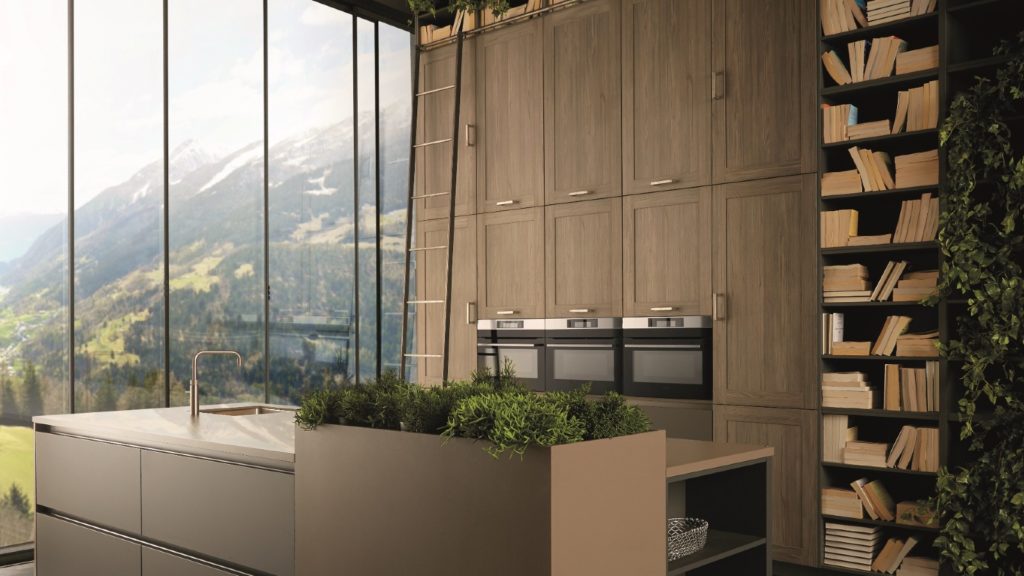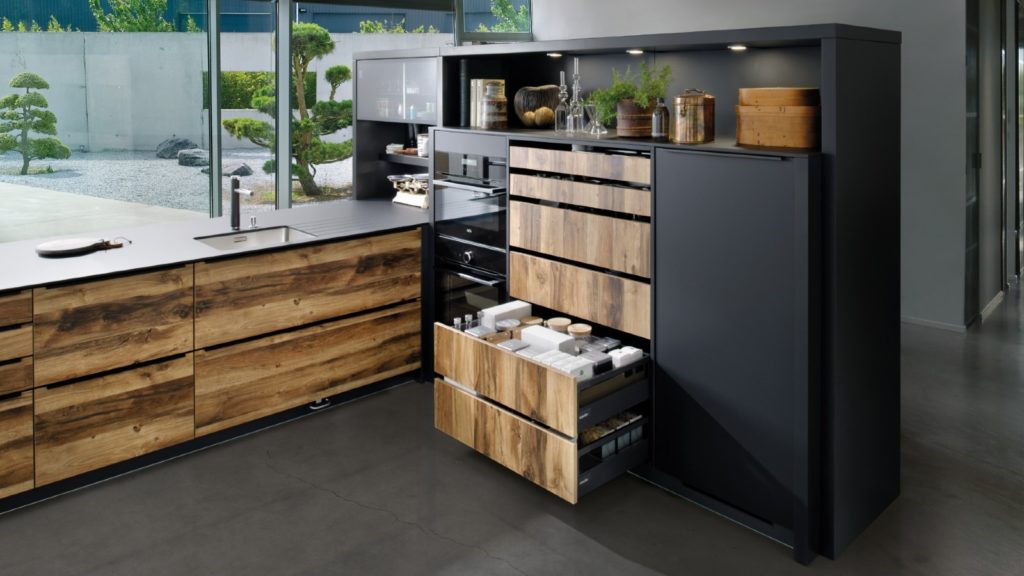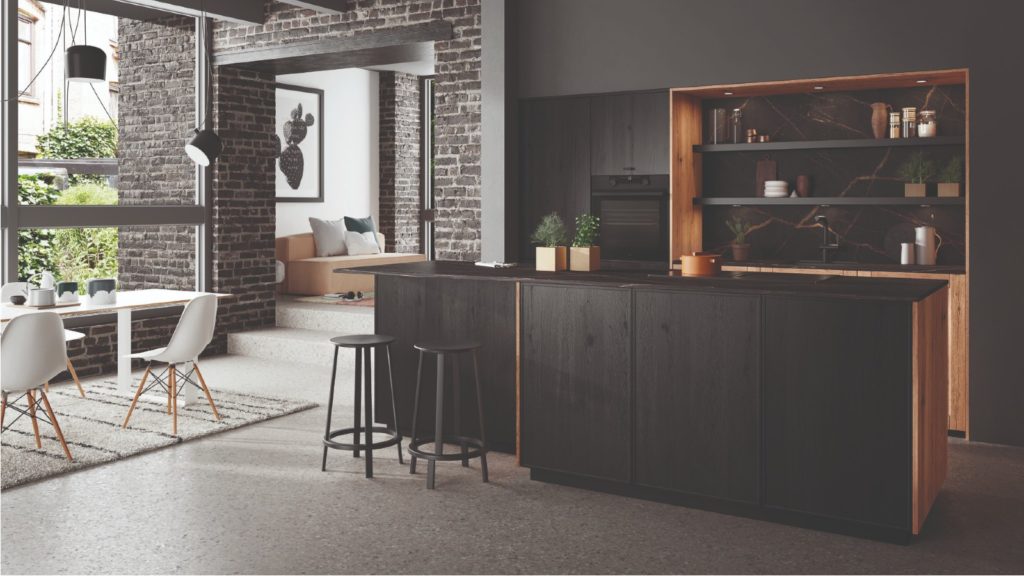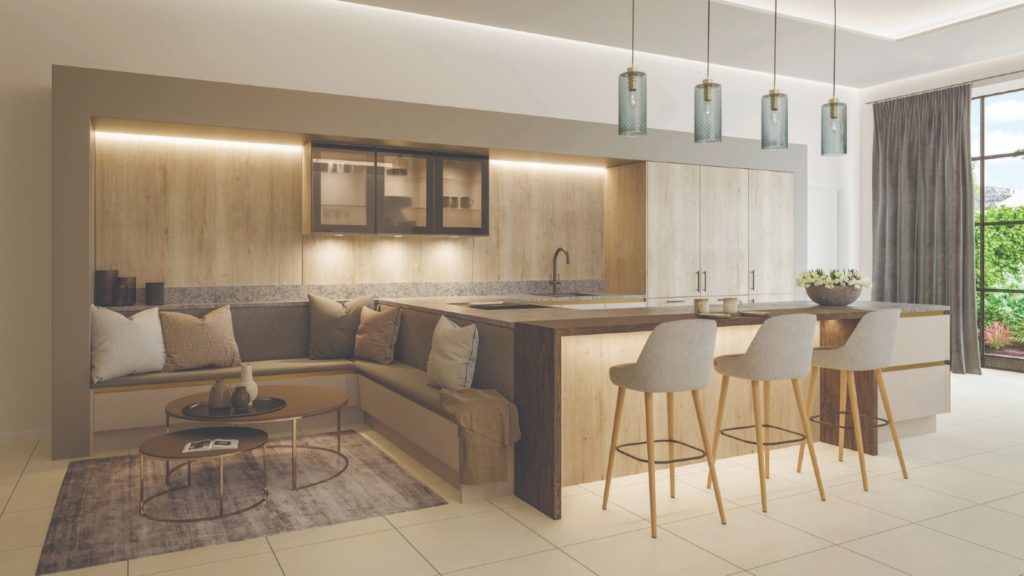Timber has come to the fore in contemporary kitchen furniture, as consumers seek the warmth, reassurance and authenticity of wood.

Offering a modern twist on a classical Shaker design, Cascada from Keller comes in 13 colours and nine wood decors, including Cascada Graphite Fleetwood, an on-trend dark wood-look melamine door.
Wood has long been a preserve of classical kitchen furniture providing timeless appeal; however, it is now making headway in more contemporary schemes.
Supplementing the stark simplicity of minimalist door fronts, timber or wood effects offer added warmth and texture for a cosier living space and provide a grounding from nature.
Sponsored Video
In fact, tactile timber has been identified as a key kitchen trend for 2022.
National sales manager UK for Keller Kitchens Tim Spann comments: “There has been a trend towards woods and faux woods in more contemporary kitchen styling which has added to already strong sales in the more traditional kitchens.”
And, he explains, this has filtered down the market: “There is growing demand for a natural look in market segments a little lower down the price spectrum than the normal higher ground for such products.”
Creating connections
Wood enables a greater connection in kitchen architecture, embracing the external environment, as commercial director of Brandt Design Julia Steadman comments: “The rise of indoor/outdoor living has renewed interest in natural materials and biophilic design as homeowners look to create unique family rooms which also extend to the garden space via a patio.”

The Arcos kitchen from Schmidt features Murphy vintage wood and Nano Black worktop and units.
It also helps bring together internal spaces, creating a holistic living environment, as Steadman continues: “Timber can also be a complementary material for modern fitted kitchens in period conversions, helping to marry architectural details with the dark jewel tones of fashionable dark painted kitchens.”
Modern material
Although a traditional material, woods are now being used in new and inventive ways, with a variety of species, graining and textures to provide a wide choice of aesthetics.

The Memory SL Zero Black door front by Rotpunkt is shown on the island unit and integrated wall units in combination with Old Forest Oak as a contrast design detail.
Director at Drew Forsyth George Forsyth explains: “Wood works on so many levels – from the raw, untreated timbers seen so often in industrial-style kitchens, to the pale wood of the Scandi movement and the classic country-style knotty timber for a rustic look.”
However, industry experts believe there is a move towards richer woods for luxe finishes in kitchen furniture.
Managing director of Daval Simon Bodsworth points out: “The trends for rich, dark colours is encouraging designers to explore the different types of wood species available, with browns and blacks being introduced through rustic wood veneers, charred timber effects and matt black accessories.”
He continues: “We are finding there is increasing sophistication in finishes which nod to an industrial look such as charred Japanese wood effects with a metallic tinge and character oak which recreates the look of distressed wooden planks.”
Area sales manager for Pronorm Chris Cuthill agrees on the trend for richer tones but says it is being led by walnut: “We have seen a significant move towards walnut recently, which has led our product development team to bring two very rich veneers into our portfolio.
“We are seeing dark and moody woodgrains bring strongly favoured by retailers at the design and specify stage.”
While timber choice may vary from client to client and project to project, Julia Steadman says it’s smaller details such as grain which can make a difference. “When chosen with care, I feel that graining can be a highly distinctive designer detail both in minimal contemporary kitchens and when character graining is visible under a painted kitchen door for an extra luxe textural feel.”
Mix and match
The wide choice of wood and its inherent ability to mix and match with materials, which has seen it become part of eclectic and personalised interiors.

Combining the Pronorm Y Line and 128 kitchen design, Pronorm offer a kitchen with earthy tones of organic matt black with a walnut wood-effect laminate in an ultra matt texture.
Head of UK operations at Rotpunkt UK Matt Phillips says it can be used effectively with colour, commenting: “Well-balanced contrasts of low-key block colours and natural wood accents are inspiring a fresh approach to user-friendly working spaces, which are designed to balance the complex needs of a modern household.”
Julia Steadman of Brandt Design says anything goes when using wood, and says it be used alongside colour or contrasting species: “We have used veneers as accents on island units and breakfast areas to contrast with fashionable pale grey units as well as making a feature of a giant timber gale end in a family kitchen.
“Mixing different woods, such as walnut with pale oak, is an excellent way to make a space feel even more distinctive, helping to zone and define the kitchen living space, as well as adding personality.”
Seeking sustainability
Interestingly, the use of timber or wood effect in contemporary kitchens seems to be more than a passing trend.

Reflecting the trend for Scandi styling is Alaskan Oak by Daval, a white-washed oak effect with naturalistic knots, shown on its Varenna furniture, combined with Talpa which has a matt finish in Taupe
Buoyed by a post-pandemic landscape, consumers now seek authenticity in materials and home design that is sympathetic to the environment.
Market leader for trends, styles and colours at Schmidt Maryline Stoekel agrees, saying it’s about going back to basics: “There is a growing trend from consumers for more eco-responsible materials.”
Matt Phillips of Rotpunkt UK concurs and points out the advantage for the kbb industry: “Eco-credentials are a growing concern for homeowners, and I think that if the building and interiors industry invests in more sustainable processes, it will make a huge difference to future generations as well as generate a better bottom line.”
In fact, Simon Bodsworth of Daval believes sustainability will form an integral part of interior aesthetics, as he concludes: “I see two key looks dominating the kitchen market going forwards – Refined Country, inspired by the timeless beauty of painted Shaker-inspired furniture and Natural Renewal, in which recycled materials and tactile surface treatments and finishes take precedence, so both will be underpinned by the beauty of wood and wood effects.”



